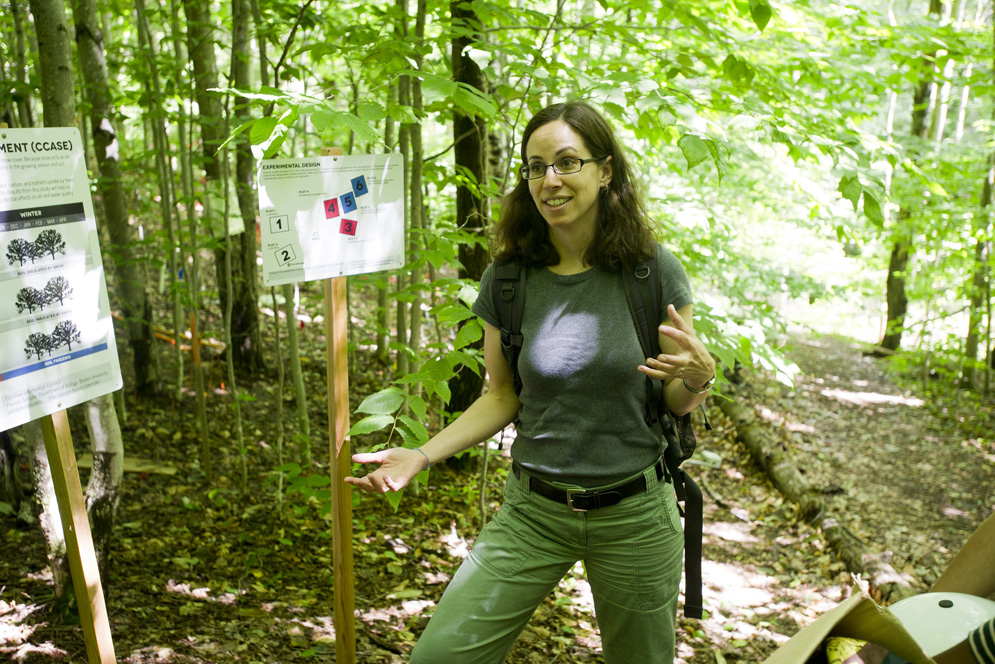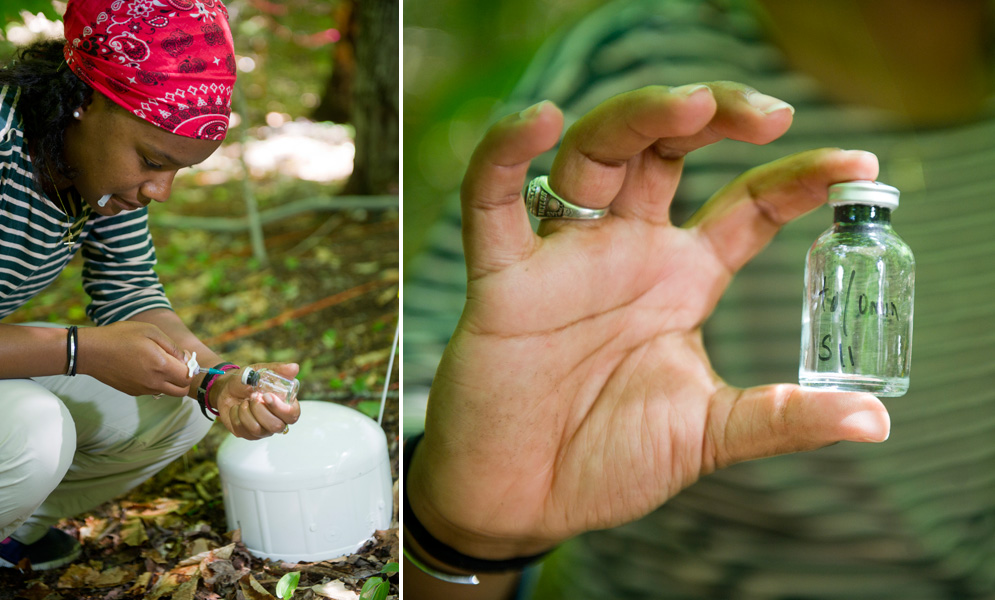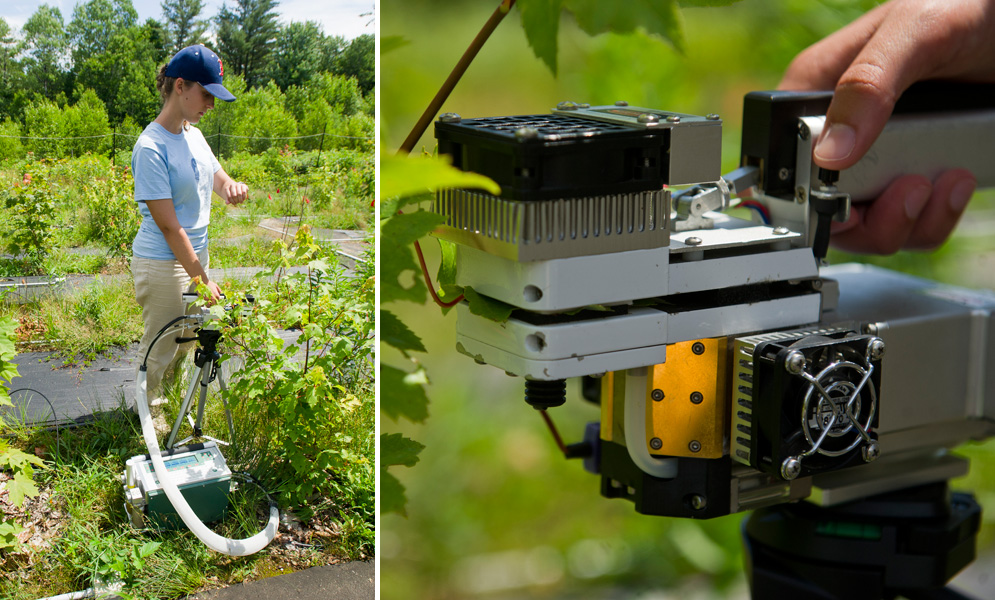CAS researchers heat a forest floor to study climate change
CAS researchers heat a forest floor to study climate change

Pam Templer, a CAS associate professor, and her students buried two-plus miles of heating cables in the New Hampshire woods to study climate change. Photos by Cydney Scott
You call this science? Pam Templer’s students might have been forgiven for asking that question two years ago as they hopped on shovels like pogo sticks to carve trenches into the root-laced floor of New Hampshire’s Hubbard Brook Experimental Forest. The laborious six-week dig, requiring up to eight workers a day, culminated with the burial two and a half miles of heating cables four inches underground.
It sounds like a home-improvement crew taking a wrong turn en route to a job, but the students’ gymnastic exertions and woodsy cable-laying were vital to Templer’s study of climate change. Since April, when researchers turned on the power (they waited so long to let the forest recover from the assault, she says) the cables have been warming the soil by 5 degrees Celsius. It’s a crystal ball of sorts: that temperature rise is what’s projected for soils in the Northern Forest (the region of northern Maine, New Hampshire, Vermont, and New York) over the next century. What will those warmer temperatures do to the health of the forest’s trees and soil organisms? That’s what Templer, a College of Arts & Sciences associate professor of biology, wants to know, and it’s why her student Taylor Barrow (CAS’16) knelt on the forest floor one day in late July, collecting soil gas samples.
Barrow worked on one of several plots traversed by the underground cables in the US Forest Service research site. (While you can’t see the cables, the white three-inch-by-three-inch power boxes sprouting like mushrooms from the forest floor give away their presence.) Barrow placed an airtight chamber resembling a cake dome on the ground to contain the greenhouse gases that are naturally emitted by soil microbes. She jabbed a syringe through the dome and pulled the plunger, sucking gas into the syringe’s tube for placement in a vial. On this particular day, she collected 96 vials from 6 plots throughout the forest.
The data she collected, along with gas readings from control plots not warmed by the cables, will indicate how soil-emitted gases might be altered by climate change. That’s important, Templer says, because Northeast forests currently are a net carbon sink, meaning they take in more carbon than they release. If summers are longer and warmer in the future, could that flip the forests into a carbon source, giving off more carbon than they take in? “That would not be good,” Templer says, “because right now, they offset a lot of our carbon emissions for the northeastern United States.”

This summer work is an extension of winter research that Templer and her team have been doing with a National Science Foundation CAREER grant. The cold-months study, which looked at how decreased accumulations of soil-insulating snow from a warming climate would impact trees, revealed that soil freezing damages tree roots by impairing their ability to take up nutrients and water. It also reduces the abundance of insects in the soil, harming the woods’ biodiversity.
But wait—climate change means summers also will be warmer, with warmer soils and longer growing seasons; might that not counter the bad effects of winter? The BU researchers are trying to answer that question, with the help of those underground cables.
They borrowed the idea of cabling Hubbard Brook from Harvard Forest and other places where researchers are warming soils throughout the year. Unlike the Harvard Forest work, she and her team are examining the combined effects of colder soils in winter and warmer soils in summer on northern forests. She and her students are working with six plots. Two are control sites with no heat from the cables; two are warmed during the summer but not in the winter; and two are warmed during the summer and cleared of snow (to induce soil freezing) in the winter. After the soil in those plots has been frozen for three days, the cables are turned on and the ground is thawed.
These different treatments across multiple plots will help the researchers determine if the summer warming might offset the damage done by the winter freezes. “Is the future going to be better or worse? It’s hard for me to put a judgment on it, but we really need to look at the net effect of all these changes at once,” Templer says. “We’re trying to get at that a little bit more than what we’ve done in the past—just focusing on the winter—and saying, OK, across the year, now what’s going to happen?”
If you want to see forests reacting to a warmer future, why not just study trees in warmer climates? The problem, says Templer, is that forests are subject to more influences than climate change—pollution, soil, and geological differences—and it’s hard to parse which influence, or combination of influences, is responsible for changes in forest health.

Barrow’s is one of several Undergraduate Research Opportunities Program studies Templer oversees at Hubbard Brook. The same day Barrow did her work, another UROP student, Risa McNellis (CAS’15), clamped what appeared to be a huge staple gun on sapling leaves in another heated plot. The clamp was hooked to an analyzer to measure photosynthesis, with a particular focus on how much carbon the leaves were plucking from the atmosphere. McNellis hopes to learn if projected changes in climate will diminish the carbon that plants take up, leaving more carbon in the atmosphere and thereby fueling even more climate change.
Higher temperatures “generally lead to more photosynthesis, because that’s how leaves take up carbon,” says McNellis. “But when soils freeze in winter, that can damage the roots and limit the amount of nitrogen they’re able to take up, which is a limiting factor in photosynthesis.” Her work is mentored by Templer and by PhD candidate Rebecca Sanders-Demott (GRS’16); while Andrew Reinmann (GRS’14,’15) was Barrow’s other mentor.
Templer originally hoped for additional research plots, but “it’s very expensive to heat a whole forest.” If wiring the woods seems odd work for scientists, you should see them when they study leaves from the canopies of tall maples at Hubbard. “Do you know how we collect leaves from the top of the trees?” Templer asked. “Shotgun.” A US Forest Service staffer peppers treetops with pellets to bring down branches, all in the service of science.
Comments & Discussion
Boston University moderates comments to facilitate an informed, substantive, civil conversation. Abusive, profane, self-promotional, misleading, incoherent or off-topic comments will be rejected. Moderators are staffed during regular business hours (EST) and can only accept comments written in English. Statistics or facts must include a citation or a link to the citation.